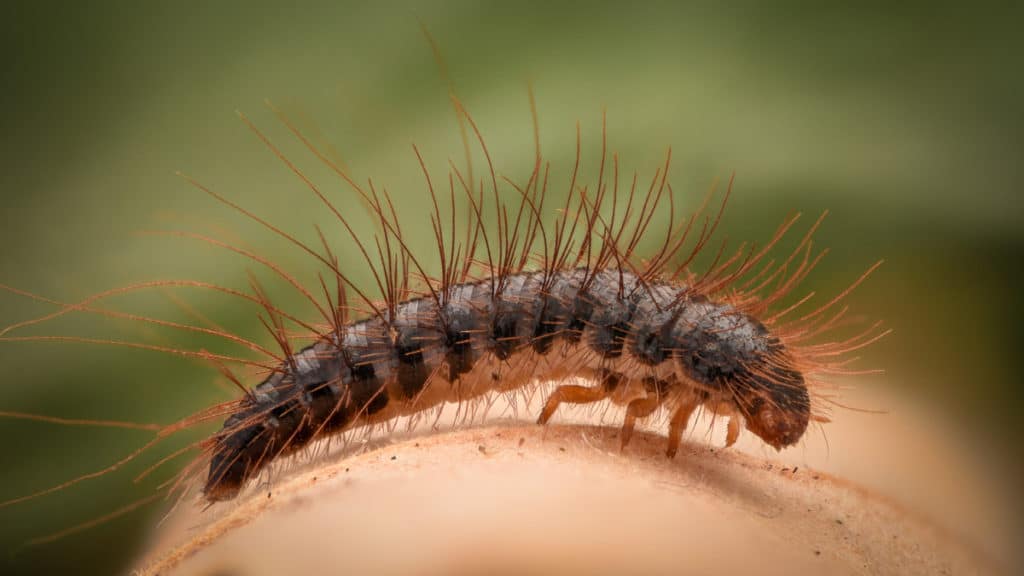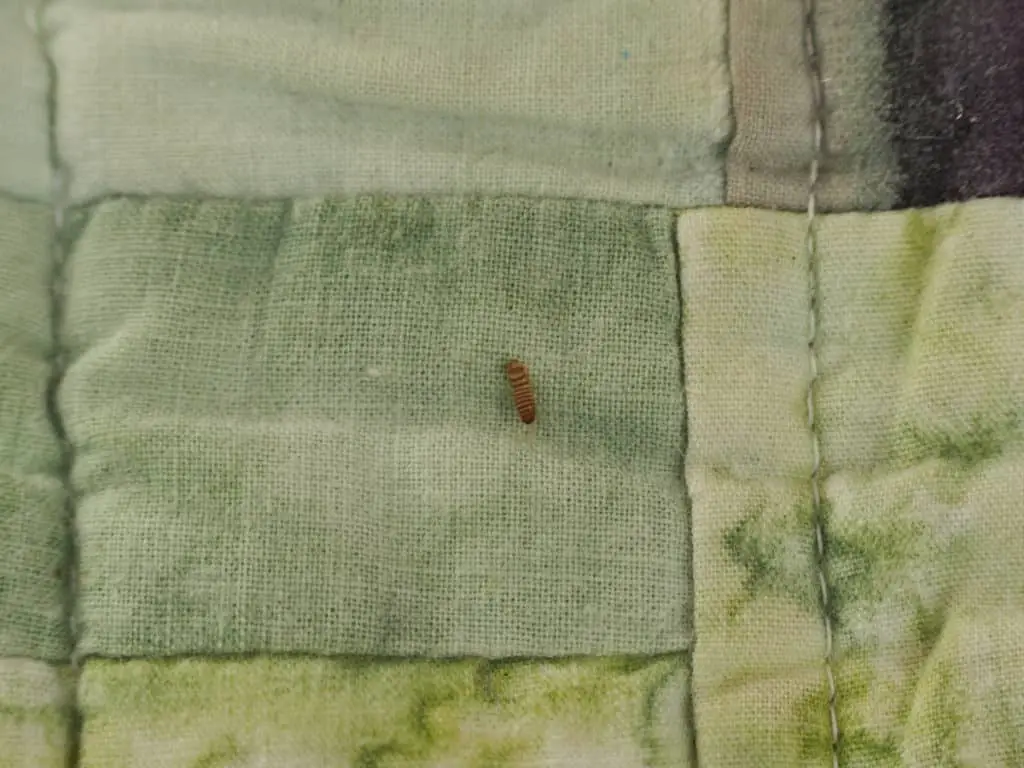Seeing carpet beetle larvae can cause panic for some people particularly if you don’t know a whole lot about them. There are certainly some bugs out there that can bite you, after all, carpet beetle larvae can chew through clothing and fabrics could they also bite people?
Do carpet beetle larvae bite? Carpet beetle larvae don’t bite. They can cause an allergic reaction in people with sensitive skin making you feel like you have been bitten. Carpet beetle larvae don’t feed on living things rather feed on animal-based materials, including felt, silk, fur, feathers, leather, skins, and wool.
It is essential to understand the physical make-up of carpet beetle larvae to understand why interaction with one can be painful, leaving you thinking you have been bitten.
Read on, and let’s discover what you expect when you encounter carpet beetle larvae and adults.
The Anatomy Of A Carpet Beetle Larvae
These little creatures feature hair-like bristles on their bodies that are quite hard. When they come into contact with human skin, they prick and can even cause an allergic reaction in some people. It is the pricking of these bristles that can cause one to think they have been bitten.

These larvae are brown and look like worms. A closer glance will reveal an oval-shaped, 4-5mm long body with whitish bands. You will also notice extensions protruding from both sides of their bodies.
They can grow to 8mm in length and move around looking for food using the three pairs of legs on their bodies’ underside. Carpet beetle larvae have a distinct head and chewing mouthparts but they do not have biting mouthparts
The larvae of carpet beetles are even more destructive than adult carpet beetles.
Are Carpet Beetle Larvae Capable Of Biting Humans Or Pets?
Carpet beetle larvae are scavengers by nature, meaning they eat dead organisms. As such, they do not pose a risk to human beings or pets. But they will feed on human hair and dead skin when they come across it in under boards, closets, and chests.
Just like the larvae pose no threat to humans, neither do the adults; In fact, once the larvae molt into adults, they switch their diet from predominantly animal-based materials to pollen and nectar. They only come indoors during the mating period, and that is when they leave the destructive larvae behind.
There is a myth that carpet beetle larvae burrow into your skin. That is not true. But these larvae will burrow further into dried food, into their larval skin, or their habitat when they are ready to pupate. That is the stage right before they become full adults.
What Do Carpet Beetle Larvae Feed On?
These larvae prefer to feed on the following:
Animal Products
- Skin
- Fur
- Feathers
- Hair
Natural Fibers
- Cotton
- Silk
- Wool
- Linen
Dead Insects
- Flies
- Ants
- Crickets
Dried Foods
- Grains
- Pet food and crumbs
But they cannot digest cellulosic fibers like those found in synthetic materials like polyester, acrylic, nylon, and even some natural fibers like rayon. So, they tend to leave those alone. But if these materials have food stains or are dirty after you have used them, they may also be susceptible to these pests.
Carpet beetle larvae eat your clothes and other animal products because they need keratin. Keratin is a protein that is present in skin, hair, nails, among others. The keratin helps them develop into adults then they graduate to getting their keratin from pollen instead of animal-based materials.
If you are worried you might have carpet beetles in your house it would be worth checking out this article we have written, What Causes Carpet Beetles? What Should You Watch Out For?
Where Are You Likely To Find Carpet Beetle Larvae?
You will find the larvae in places where there is very little light coming in. Inspect your carpets, blankets, furniture, and rugs, as well as dried food products like pet food and grains.
Other places where they like to hide include the air vents, air ducts, attics, basements, and pantries. Also, check the edges of your carpets and rugs because that is where they love to congregate and hide. Don’t forget to check the beds in your house.

When it is mating season, they are attracted by the light, and they can be found on the window sills and next to light fixtures. Carpet beetles are also good climbers and can be seen climbing walls.
Seeing adult carpet beetles flying indoors should raise a red flag because it means that their larvae are not far. The females lay more than 100 eggs with each cycle and these hatch into larvae within 7-30 days.
Unfortunately, most people realize they have an infestation only when apparent damage occurs on their clothes, rugs, and furniture.
Do Carpet Beetle Larvae Molt?
Yes, carpet beetle larvae do molt, and the skin they leave behind can cause an allergic reaction when it comes into contact with human skin. Some people may get dermatitis just from contact with this dead skin.
The skins are left behind as the larvae graze along the surfaces. So, do not be surprised to find the molted skin on different surfaces, which indicates where they are feeding.
The good news is that even when you come into contact with a carpet beetle larva, its effect on your skin is not long-lasting or life-threatening. Most people only experience a rash, which clears up after a while.
So we now know that carpet beetle molt. What about poop? Are you likely to find carpet beetle poop? Check out this article we have written for all the answers, Do Carpet Beetles Poop And What Does It Look Like?
How To Manage A Carpet Beetle Larvae Infestation
Carpet beetles and their larvae are best removed by a professional because it can be hard to find their eggs and pupa. During the egg and pupa stages, the beetles are completely inactive, so you may not be aware of the infestation. Management of carpet beetles may need a couple of weeks, and you have to vacate your space.
On your end, you need to practice and maintain proper hygiene and keep your space clean. Clean your out-of-season clothing items regularly and check for any damage. The damage will appear as bald patches on the piece of clothing.
Ensure that you clean the clothing that you have worn and soiled with your sweat and food particles. These things will also attract roaming carpet larvae to your clothes, leading to an interaction between your skin and their bristles.
Socks, gym clothes, sweaters, and also house slippers are susceptible to these pests.
Also, make sure that you vacuum your carpets and rugs frequently. Even new rugs and carpets need to be cleaned thoroughly and often. Just because they are new doesn’t mean they are not susceptible to becoming a home to carpet beetles and their larvae.
Finally, consider storing your clothing and other fabrics inside plastic containers or the bags available to store linen and other clothing.
The Wrap Up
Ultimately, carpet beetle larvae’s ability to digest keratin makes them valuable in the larger scheme of things. As scavengers, they play a role in keeping the ecosystem clean by eliminating insects and animals.
Unfortunately, they pose a problem when they invade those fabrics or materials you are using in the house, especially if you are into taxidermy or you keep untreated skins and other animal products in your space.
Sources
https://entomology.ca.uky.edu/ef601
https://www.healthline.com/health/do-carpet-beetles-bite
https://extension.umaine.edu/ipm/ipddl/publications/5008e/
https://www.yates.com.au/plants/problem-solver/pests/carpet-beetles/
